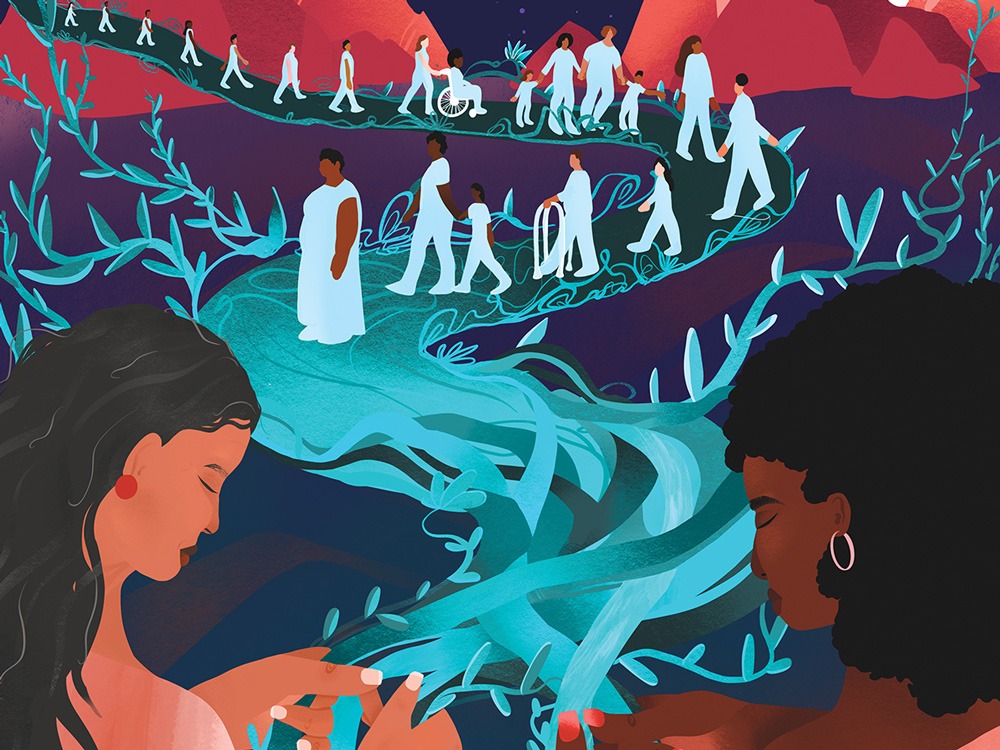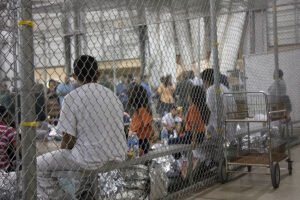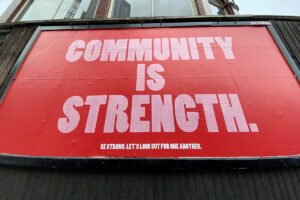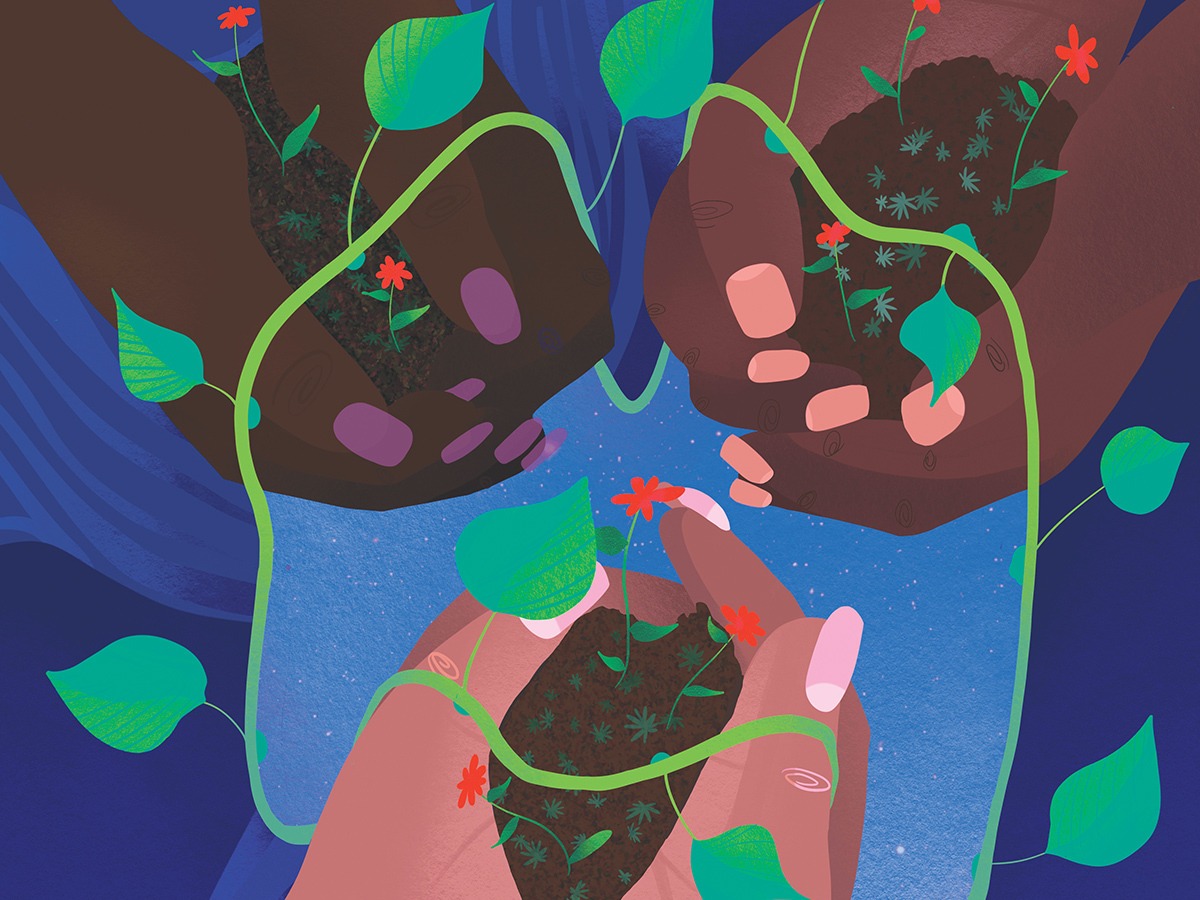
Click here to download this article as it appears in the magazine, with accompanying artwork.
Editors’ note: This article is from the Winter 2021 issue of the Nonprofit Quarterly, “We Thrive: Health for Justice, Justice for Health”
Shared language around the experience of disability is a starting point for having increased choices in the world. It also helps ensure people with disabilities are respected for who they are as people. Practice and policy must shift to become person-centered.
Disability is a core justice issue, but people with disabilities are often an afterthought where social justice is concerned. Unless you have a disability or a relationship with a person who has a disability, the barriers to full inclusion may not be immediately visible; but inherent bias and a lack of engagement of people with disabilities have led to separate, segregated service models that continue to isolate people with disabilities from the community and their typical peers. The “invisibility” of people with intellectual and developmental disabilities (IDD) to typical citizens has long been a marker for potential abuse and neglect.1
Disability cuts across all segments of society. Even though an estimated sixty-one million American adults have a disability and about seven million Americans have intellectual and developmental disabilities (IDD), the challenges faced by people with disabilities remain largely hidden from view, and systems of support are often lacking.2 Opportunity exists to build neurodiversity and disability into justice conversations.3 A recent study showed that 90 percent of companies had diversity priorities, but only 4 percent factored in disability.4 Certainly, the conversation about diversity, equity, and inclusion (DEI) is not a new one in the nonprofit sector. Increased consideration for “accessibility” is gaining traction as DEIA (diversity, equity, inclusion, and accessibility) reflects issues of ableism and sanism.5 It also signals greater attention and investment from nonprofit and other leaders.
Broadly speaking, equity and inclusion initiatives have increased in prominence in the nonprofit sector in the wake of the movement against anti-Black racism, thanks to the activist efforts of the Movement for Black Lives (M4BL) and Black Lives Matter keeping antiracist work front and center. According to Nonprofit HR’s 2021 Nonprofit Diversity Practices report, Black Lives Matter “responses” inspired 63 percent of 675 North American organizations to make “adjustments to prioritize/reprioritize diversity objectives, programs and/or initiatives.”6 Of the surveyed organizations, 28 percent also reported that they planned to increase or had increased their diversity budget.7 However, only 6 percent had provided “ability-centered training.”8
The structural exclusion and underfunding of disability programs create troubling outcomes that appear at each life stage for people with disabilities.9 Special education funding through the Individuals with Disabilities Education Act (IDEA) has not progressed alongside existing needs.10 In 2020, Congress funded only 13.2 percent of its 40 percent contribution—leaving states and local districts on the hook for $24 billion in costs.11 Like so much in the disability sector, service funding varies across individual states and becomes an annual advocacy charge to maintain or even meet the status quo.12
Putting the Person First
A justice lens begins with putting the person first when referring to the experience of disability: a person with developmental disabilities; a person who resides in a group home. It’s about acknowledging the experience of disability for a person rather than using a diagnosis to define a person’s personality, interests, or goals.
When possible, consider not referring to the disability at all and just tell the story. Language goes to deeper issues that tie to visibility and the systemic exclusion of people with a disability. Some people live independently, in supportive apartments, in group homes, or with their families. How people with disabilities process and engage with the world is as varied as the human experience itself.
Society’s general unwillingness to engage people with disabilities—as individual people rather than as some abstract public policy area—has a “devastating effect” on an ongoing basis, according to a study out of the United Kingdom from 2018, showing that the perception gap of disability prejudice has more than tripled since 2000.13 Negative perceptions of people with disabilities persist “from the seemingly benign to overt discrimination.” Displaying “commonly held” attitudes, the study showed 75 percent of respondents perceiving people with disabilities “some or most of the time. . . needing to be cared for,” and 13 percent “hardly ever or never think(ing) of (people with disabilities) as the same as everyone else.” Negative perceptions of people with disabilities shifted according to the quality of relationships with those who had disabilities—and were likened to “long-term contact” with other diverse populations. The disability charity Scope shared these results from a 2017 British Social Attitudes survey of “a nationally representative sample of around 3,000 people,” focused in part on the experience of living in the United Kingdom.14
Increased attention to the dominance of ableism and sanism is needed at a time when disparities that impact vulnerable populations continue to surface. For children with disabilities, the use of electric shock devices is still legal in several states, despite being deemed torture by the United Nations.15 In the past year, the Food and Drug Administration sought to ban such use, but was overturned by the United States Court of Appeals for the District of Columbia Circuit.16 Just as the Centers for Disease Control and Prevention declared racism “an epidemic impacting public health,”17 children of color remain underdiagnosed with autism and developmental disabilities.18
Disability Discrimination
COVID-19 has spotlighted bioethical questions and the gaps in equitable treatment. Adults with disabilities who are as young as eighteen live in nursing homes or institutions due to a lack of home- or community-based alternatives in their state.19 During the pandemic, this setting exacerbated issues, ranging from higher infection rates to unequal access to vaccines to a lack of timely guidance on virus monitoring or social distancing.20 In such settings, deaths have been underreported.21 Disability discrimination also appeared in reported incidences of ventilator-use limits, triage biases, and denial of care.22
Outside of pandemic realities and despite more than thirty years of the Americans with Disabilities Act of 1990 and its antidiscrimination mandate, people with disabilities remain one of the most vulnerable groups in the United States.23 They are more likely to be unemployed, victims of crimes, and live in poverty.24 Thirty- eight percent of state and federal prisoners have at least one disability, according to a 2016 Bureau of Justice Statistics report. Of those disabilities, the most common is a cognitive disability (23 percent).25
Segregation, casual prejudice, and isolation continue to separate people with disabilities from full community inclusion and the opportunity to lead the lives they choose.26 Funding for services that assist people with disabilities to more fully participate in the community remains inadequate. Disability advocates campaigned for the Better Care Better Jobs Act—currently under review by the Senate Finance Committee—because it increased Medicaid funding for home and community–based services (HCBS),27 among other key investments, such as the direct care workforce.28
Community integration was advanced by the U.S. Supreme Court in Olmstead v. L.C. (1999), known as the Brown v. Board of Education of the disability rights movement.29 Rejecting segregation and wide-spread institutionalization, the Olmstead ruling held that people with disabilities had the civil right to live in the community with state-funded supports30—albeit with approval from treatment professionals who determined that they met specific criteria. Under Title II of the Americans With Disabilities Act, such community-based services must be provided when medical professionals find it “appropriate,” and the person to be supported chooses such an option and “can be reasonably accommodated, taking into account the resources available to the State and the needs of others with mental disabilities.”31 Yet the flexibility of Olmstead enables states to, at a “reasonable pace,” maintain ongoing waiting lists to “transition” people into the community; integration efforts continue to evolve via Medicaid access and funding.32
Olmstead violations occur on an ongoing basis and are addressed by the U.S. Department of Justice (DOJ) and Department of Health and Human Services’ Office of Civil Rights (OCR).33 According to a 2019 report from the Medicaid and CHIP Payment and Access Commission (MACPAC), there were over fifty “integration matters” addressed by the DOJ in twenty-six states and D.C. from 2009 to 2016. The OCR “intervened,” “often with DOJ,” in more than “80 cases of Medicaid beneficiaries in institutional or segregated settings as well as for persons at-risk of institutionalization or loss of community-based services.”34
Policy Perils
Medicaid also funds direct care for people with disabilities. The professionals undertaking this work are known in the industry as direct support professionals (DSPs). The DSP role and term are not well-known outside of the disability sector. It’s a profession requiring talent and care of the most intimate parts of a person’s life. This lack of recognition unfortunately corresponds with “an average annual turnover rate of 45 percent” and “an average pay of $10.72 per hour”35—which, according to Nicole Jorwic, senior executive officer, state advocacy, and senior director, public policy, at The Arc—was a statistic from before COVID-19; since the pandemic, turnover probably even increased.36
Sign up for our free newsletters
Subscribe to NPQ's newsletters to have our top stories delivered directly to your inbox.
By signing up, you agree to our privacy policy and terms of use, and to receive messages from NPQ and our partners.
“We are requiring people to be impoverished in order to access these services, and then on the flip side of that the workforce is not making a living wage,” said Jorwic.37
These positions are primarily held by women of color.38 The Arc—as part of the Care Can’t Wait coalition, which includes the National Women’s Law Center and TIME’S UP Foundation—is advancing an agenda with requests including “the investment of $400 billion in Medicaid home and community-based services.”39
The Better Care Better Jobs Act brings to life the American Jobs Plan proposal for $400 billion in funding for home- and community-based services. Though not all of that money will support the DSP workforce, such an investment will begin the important work of improving supports for more than 3.2 million Americans, including senior citizens and people with disabilities, to lead lives of increased independence and inclusion.40
For Jorwic, like many advocates, full integration in society remains a critical focus. Disability was part of the fabric of Jorwic’s life, from being a student in the “first included classroom in her school district” to being a sibling advocate for her brother, Chris. “There’s a huge deficit in understanding in the general public of the disability experience . . . (and) of the history of the disability rights movement,” said Jorwic. “We need to make people comfortable with using language around disability and incorporating people with disabilities and their stories into things that aren’t necessarily about disability specifically.”41
This lack of understanding and shared language, according to Jorwic, also impacts policy-makers through inconsistent language provided by constituents when sending legislative requests and in data collection. For example, DSPs do not currently have a standard occupational code, which impacts workforce statistics.42 Data are also lacking around “the places where people with disabilities were living during the pandemic,” according to Jorwic.43
“A lot of support for people with disabilities is funded through Medicaid, which is a federal program run by states. It’s called different things in different places. This leads to confusion for families and for media . . . (and) state and federal government when it comes to data collection,” said Jorwic.44 In Illinois, community- based residences are called community integrated living arrangements (CILAs). New York, instead, has individualized residential alternatives (IRAs). Unsurprisingly, “because of that variation, we don’t have a lot of national data when it comes to settings ultimately or during COVID specifically for people with disabilities.”45
Socially enforced invisibility, isolation, and social barriers divide people with disabilities from their peers and endanger them. The divide begins almost imperceptibly in early childhood, when students with disabilities are placed on a separate track from their peers. This impacts the quality of education these students receive, which is also affected by race and class.
Bernard Baker, president of Self Advocates Becoming Empowered (SABE), a national nonprofit, remembers the challenges of being in a chair and special education classrooms at a time when to be included in typical classrooms meant having to be carried up and down flights of stairs. After decades of advocacy across a number of states, Baker believes that normalizing the experience of disability is a value of compassion and community that should begin in childhood.
“[People] are afraid to ask you what happened, and they’ll sit there and stare at you. When I went to high school, a lot of people . . . were afraid to talk to me,” said Baker. “What I want people to understand is that we’re people first. Disability comes second.”46
Hezzy Smith, director of advocacy initiatives at the Harvard Law School Project on Disability, agrees. Smith is a sibling advocate, has volunteered at Special Olympics, and sees his support of the disability sector as “always
. . . just a part of life.” In addition to increasing meaningful self-advocate roles at provider agencies, Smith says that “people with intellectual and developmental disabilities need to be hired by those state and federal organizations to be quality control specialists.”47
Increased inclusion would lead to “a win-win, because the policy-makers, administrators, and auditors would have an array of people who could bring potential flags to their attention,” as well as “provide jobs to the people with intellectual and developmental disabilities to whom they’re paying lots of taxpayer dollars to just provide services,” said Smith.48
For Smith, “Without it even being altruistic, it would make good business sense in a lot of these cases to get people with intellectual disabilities on boards, employ them as consultants, and use their expertise to enhance whatever you’re offering.”49
As a self-advocate, Baker, a father who dreams of opening up his own transportation company and has taught people who recently developed disabilities to ride the bus, is interested in more than a seat at the table. He wants to ensure that his voice is not only heard but also valued. For people uncertain about how to speak about the experience of disabilities, Baker proposes that they “invite people with disabilities to come in and talk to their employers.”50
***
Shared language around the experience of disability is a starting point for having increased choices in the world. It also helps ensure people with disabilities are respected for who they are as people. Practice and policy must shift to become person-centered. For individuals, signing up for advocacy alerts or following disability rights organizations online can help keep them informed about federal and state legislation, where lawmakers may need to see constituent support for disability issues. Organizations can join this call to action by developing training and evaluating gaps in their operations and culture. It’s a matter of placing value on different abilities and experiences.
In order for deep change to take place, Baker insists that people with disabilities need a seat at the table. “People with disabilities need to be included in all segments of the government. And we don’t need to be included in the middle, when people are planning stuff for us; we need to be included from the beginning. When you leave out people with disabilities and put them in the middle, then we’re lost—because we’re trying to fill in something that somebody else started.”51
Notes
- Vincent Palusci, Ellen Datner, and Christine Wilkins, “Developmental disabilities: Abuse and neglect in children and adults,” International Journal of Child Health and Human Development 8, no. 4 (October 2015): 407–28; Laurine Blonk, “Micro-recognition, invisibility and hesitation: Theorising the non- encounter in the social inclusion of people with intellectual and developmental disabilities,” Journal of Intellectual & Developmental Disability 46, no. 1 (March 2021): 6–14; Joan Petersilia, “Invisible Victims: Violence Against Persons With Developmental Disabilities,” Human Rights 27, no. 1 (Winter 2000): 9–12; and Benjamin Weiser, “Beatings, Burns and Betrayal: The Willowbrook Scandal’s Legacy,” New York Times, February 21, 2020, nytimes.com/2020/02/21/nyregion/willowbrook-state-school-staten- island.html.
- “Disability Impacts All of Us,” Disability and Health Promotion, Centers for Disease Control and Prevention, accessed November 29, 2021, gov/ncbddd/disabilityandhealth/infographic-disability- impacts-all.html; and “How many people with intellectual or developmental disabilities live in the United States?,” The Residential Informational Systems Project (RISP), accessed November 29, 2021, publications.ici.umn.edu/risp/2017/infographics/people-with-idd-in-the-united-states-and-the-proportion-who-receive-services.
- Keri Wiginton, “What Is Neurodiversity?,” WebMD, April 7, 2021, com/add-adhd/features/ what-is-neurodiversity.
- Nathan Friedman, “Companies are leaving neurodiversity out of their DEI conversations—and that’s a mistake,” Fast Company, June 16, 2021, com/90646292/companies-are-leaving- neurodiversity-out-of-their-dei-conversations-and-thats-a-mistake.
- Circa, “Adding Accessibility to Diversity, Equity, and Inclusion,” JD Supra, September 15, 2021, com/legalnews/adding-accessibility-to-diversity-8493447/; and “Fact Sheet: Advancing Disability Inclusive Democracy in the United States and Globally,” Briefing Room, The White House, December 3, 2021, whitehouse.gov/briefing-room/statements-releases/2021/12/03/fact-sheet-advancing-disability-inclusive-democracy-in-the-united-states-and-globally/.
- 2021 Nonprofit Diversity Practices: with new survey results (Washington, C.: Nonprofit HR, 2021).
- Ibid.
- Ibid.
- Nancy Doyle, “Neurodiversity And Intersectionality: Whitney Iles Shares On Exclusion In Autism Recruitment,” Forbes, July 11, 2020, com/sites/drnancydoyle/2020/07/11/neurodiversity-and- intersectionality-whitney-iles-shares-on-exclusion-in-autism-recruitment/.
- Evie Blad, “Why the Feds Still Fall Short on Special Education Funding,” Education Week, January 10, 2020, org/teaching-learning/why-the-feds-still-fall-short-on-special-education-funding/2020/01.
- “IDEA Full Funding: Why Should Congress Invest In Special Education?,” National Center for Learning Disabilities, accessed November 29, 2021, org/news/policy-and-advocacy/idea-full-funding-why- should-congress-invest-in-special-education/;
“IDEA Funding Gap,” Special Education Grants to States (IDEA Part B-611), National Education Association, accessed December 4, 2021, nea.org/sites/default/files/2021-01/IDEA%20Funding%20 Gap%20by%20State%20FY%202020.pdf; and “Analysis Shows State-by-State Funding Shortfalls for IDEA,” Special Education TODAY (blog), Council for Exceptional Children (CEC), February 5, 2021, exceptionalchildren.org/blog/analysis-shows-state-state-funding-shortfalls-idea.
- “Overview of Funding for Pre-K–12 Education,” American Speech-Language-Hearing Association, accessed November 29, 2021, org/advocacy/schoolfundadv/overview-of-funding-for-pre-k-12- education/; Cory Turner and Rebecca Klein, “After Months Of Special Education Turmoil, Families Say Schools Owe Them,” Morning Edition, NPR, June 16, 2021, npr.org/2021/06/16 /994587239/after- months-of-special-education-turmoil-families-say-schools-owe-them; and Joanna Allhands, “This bill could help fix a major school funding problem, but now it’s going nowhere,” Arizona Republic, April 23, 2021, azcentral.com/story/opinion/op-ed/joannaallhands/2021/04/23/special-education-funding-mess- bill-help-fix-has-stalled/7335562002/.
- “The Disability Perception Gap,” Scope, accessed November 29, 2021, org.uk/campaigns/disability-perception-gap/; and Dominic Abrams, Processes of prejudice: Theory, evidence and intervention, Equality and Human Rights Commission Research report 56 (Canterbury, UK: Centre for the Study of Group Processes, University of Kent, Spring 2010).
- Simon Dixon, Ceri Smith, and Anel Touchet, The disability perception gap: Policy report (London: Scope, May 2018).
- Robert Stack, “Other Voices: Torturing children legally at taxpayers’ expense,” Pittsburgh Post-Gazette, August 15, 2021, post-gazette.com/opinion/Op-Ed/2021/08/15/Other-Voices-Torturing-children-legally- at-taxpayers-expense/stories/202108150017; and Corey Mitchell, “The U.N. Says It’s Torture. Judges Ruled This School Can Use Shock Therapy Anyway.,” Watchdog Newsletter, The Center for Public Integrity, July 30, 2021, org/inside-publici/newsletters/watchdog-newsletter/when-a-school-turns-to-shock-therapy/.
- Brendan Pierson, “D.C. Circuit overturns FDA ban on shock device for disabled students,” Reuters, July 7, 2021, com/legal/litigation/dc-circuit-overturns-fda-ban-shock-device-disabled-students-2021-07-06/.
- “Media Statement from CDC Director Rochelle Walensky, MD, MPH, on Racism and Health,” Centers for Disease Control and Prevention, April 8, 2021, cdc.gov/media/releases/2021/s0408-racism-health.html.
- Eamon Dreisbach, “25% of young children with autism are undiagnosed,” Healio, Infectious Diseases in Children, January 21, 2020, healio.com/news/pediatrics/20200121/25-of-young-children-with-autism-are-undiagnosed.
- Joseph Shapiro, “A New Nursing Home Population: The Young,” Morning Edition, NPR, December 9, 2010, org/2010/12/09/131912529/a-new-nursing-home-population-the-young; and “The Younger Adult in the Long-Term Care Setting,” The Society for Post-Acute and Long-Term Care Medicine (AMDA), accessed December 1, 2021, paltc.org/product-store/younger-adult-long-term-care-setting.
- Thomas Goldsmith, “Pandemic cut a deep swath through NC’s centers for people with intellectual, developmental disabilities,” North Carolina Health News, August 25, 2021, org/2021/08/25/pandemic-cut-a-deep-swath-through-ncs-centers-for-people- with-intellectual-developmental-disabilities/; Chris Lee, “Many Nonelderly People With Disabilities Face COVID-19 Risks Similar to Those of the Elderly in Nursing Homes, But Do Not Have Equal Footing When it Comes to Vaccine Priority,” Newsroom, KFF, March 1, 2021, kff.org/medicaid/press-release/many- nonelderly-people-with-disabilities-face-covid-19-risks-similar-to-those-of-the-elderly-in-nursing-homes- but-do-not-have-equal-footing-when-it-comes-to-vaccine-priority/; and Susan Mizner, “COVID-19 Deaths in Nursing Homes are Not Unavoidable—They are the Result of Deadly Discrimination,” ACLU, June 23, 2020, aclu.org/news/disability-rights/covid-19-deaths-in-nursing-homes-are-not-unavoidable-they-are- the-result-of-deadly -discrimination/.
- Marina Villeneuve, “New NY governor adds 12,000 deaths to publicized COVID tally,” AP News, August 25, 2021, com/article/andrew-cuomo-health-coronavirus-pandemic-7312b49695e726eda8d5984 8e82271c5.
- Minyvonne Burke, “Ventilators limited for the disabled? Rationing plans are slammed amid coronavirus crisis,” NBC News, March 27, 2020, com/news/us-news/ventilators-limited-disabled-rationing- plans-are-slammed-amid-coronavirus-crisis-n1170346; University of Georgia, “People with disabilities faced pandemic triage biases: New study urges ERs to bring in advocates to close health care gap,” ScienceDaily, May 4, 2021, sciencedaily.com/releases/2021/05/210504112633.htm; and Joseph Shapiro, “Oregon Hospitals Didn’t Have Shortages. So Why Were Disabled People Denied Care?,” Investigations, NPR, December 21, 2020, npr.org/2020/12/21/946292119/oregon-hospitals-didnt-have-shortages-so- why-were-disabled-people-denied-care.
- Stephanie Pappas, “Despite the ADA, equity is still out of reach: Psychologists are intensifying efforts to improve health care, justice, employment and more for people with disabilities,” Monitor on Psychology 51, no. 8 (November–December 2020): 38–45.
- Gary N. Siperstein, Robin C. Parker, and Max Drascher, “National Snapshot of Adults with Intellectual Disabilities in the Labor Force,” Journal of Vocational Rehabilitation 39, no. 3 (November–December 2013): 157–65; “Violent Crime and People with Developmental Disabilities,” Disability Justice, accessed November 29, 2021, org/justice-denied/violent-crime/; and “Highlighting Disability/ Poverty Connection, NCD Urges Congress to Alter Federal Policies that Disadvantage People with Disabilities,” National Council on Disability, October 26, 2017, ncd.gov/newsroom/2017/disability- poverty-connection-2017-progress-report-release.
- Laura Maruschak, Jennifer Bronson, and Mariel Alper, “Disabilities Reported by Prisoners: Survey of Prison Inmates 2016,” Bureau of Justice Statistics, Department of Justice, March 2021, bjs.ojp.gov/library/publications/disabilities-reported-prisoners-survey-prison-inmates-2016.
- Laura R. Parker, Margo J. Monteith, and Susan C. South, “Dehumanization, prejudice, and social policy beliefs concerning people with developmental disabilities,” Group Processes & Intergroup Relations 23, 2 (February 2020): 262–84; Carli Friedman and Mary C. Rizzolo, “Friendship, Quality of Life, and People with Intellectual and Developmental Disabilities,” Journal of Developmental and Physical Disabilities 30, no. 1 (February 2018): 39–54; and Meghan Blaskowitz, Sarah Howard, and Taylor Martin, “Following Your Hopes and Dreams: A Longitudinal Study of Adults With Intellectual Disability in Transition to Community-Based Supports,” American Journal of Occupational Therapy 74, no. 4, Suppl. 1 (August 2020).
- Better Care Better Jobs Act, 2210, 117th Cong. (2021), congress.gov/bill/117th-congress/ senate-bill/2210.
- Robert Holly, “‘Better Care Better Jobs Act’ Seeks Permanent FMAP Bump, Higher Wages for HCBS Workers,” Home Health Care News, June 24, 2021, com/2021/06/better-care- better-jobs-act-seeks-permanent-fmap-bump-higher-wages-for-hcbs-workers/; and “Better Care Better Jobs Act: What Grassroots Need to Know,” The Arc, August 4, 2021, thearc.org/resource/better-care-better-jobs-act-what-grassroots-need-to-know/.
- OImstead v. L.C., 527 U.S. 581 (1999), google.com/scholar_case?case=1057318245348059744&h l=en&as_sdt=6&as_vis=1&oi=scholarr; “Olmstead v. L. C.: History and Current Status: The Olmstead Supreme Court Decision in a Nutshell,” Olmstead Rights, accessed November 30, 2021, olmsteadrights.org/about-olmstead/; U.S. Department of Justice, The Promise of Olmstead: 15 Years Later, September 16, 2020, video, 16:48, youtube.com/watch?v=jUUVKHMQl5U; and Gregory J. Boyer, “Medicaid Home- and Community-Based Long-Term Care Services in the Age of Olmstead” (PhD diss., University of North Carolina at Chapel Hill, 2013; last modified March 22, 2019), cdr.lib.unc.edu/concern/dissertations/5d86p150h.
- Olmstead, 527 S. 581.
- Ibid.
- MaryBeth Musumeci and Henry Claypool, “Olmstead’s Role in Community Integration for People with Disabilities Under Medicaid: 15 Years After the Supreme Court’s Olmstead Decision,” Medicaid, KFF, June 18, 2014, org/medicaid/issue-brief/olmsteads-role-in-community-integration-for-people-with- disabilities-under-medicaid-15-years-after-the-supreme-courts-olmstead-decision/view/print/#footnote-114885-17.
- “Twenty Years Later: Implications of Olmstead L.C. on Medicaid’s Role in Providing Long-Term Services and Supports,” IssueBrief, Medicaid and CHIP Payment and Access Commission, July 2019, macpac.gov/wp-content/uploads/2019/07/Twenty-Years-Later-Implications-of-Olmstead-on-Medicaids- Role-in-LTSS.pdf; and “Special Collection: Olmstead Cases,” Civil Rights Litigation Clearinghouse, accessed November 29, 2021, clearinghouse.net/results.php?searchSpecialCollection=7.
- “Twenty Years Later,”
- “The COVID-19 Pandemic Impact on Chapters of The Arc, Direct Support Staff, and People With Disabilities,” Survey Snapshot, The Arc, June 2020, org/wp-content/uploads/2020/06/20-150- COVID-Chapter-Impact-Survey-Summary-v3.pdf; and Nicole Jorwic, interview by Nicole Zerillo, July 1, 2021.
- Nicole Jorwic,
- Ibid.
- Direct Care Workers in the United States: Key Facts (New York: PHI, September 8, 2020).
- “Care Can’t Wait Summit,” Caring Across Generations, accessed December 1, 2021, org/ care-cant-wait/.
- MaryBeth Musumeci, “How Could $400 Billion New Federal Dollars Change Medicaid Home and Community-Based Services?,” Medicaid, KFF, July 16, 2021, org/medicaid/issue-brief/how-could-400- billion-new-federal-dollars-change-medicaid-home-and-community-based-services.
- Nicole Jorwic,
- Doris Parfaite-Claude, “Standard Occupational Code for Direct Support Professional Bill Reintroduced,” News from ANCOR, Rehabilitation and Community Providers Association (RCPA), April 29, 2021, org/standard-occupational-code-for-direct-support-professional-bill-reintroduced/.
- Nicole Jorwic,
- Ibid.
- Ibid.
- Bernard Baker, interview by Nicole Zerillo, July 8,
- Hezzy Smith, interview by Nicole Zerillo, July 6,
- Ibid.
- Ibid.
- Bernard Baker,
- Ibid.











